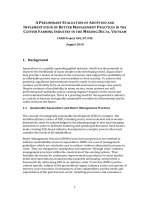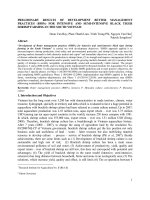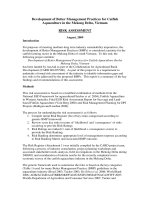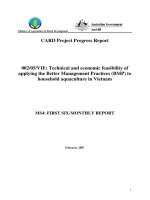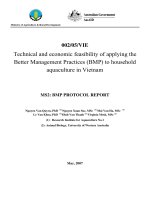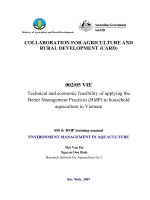Environmental management practices applied in intensive farming by selected rice farmers in victoria laguna philippines
Bạn đang xem bản rút gọn của tài liệu. Xem và tải ngay bản đầy đủ của tài liệu tại đây (2.9 MB, 120 trang )
THAI NGUYEN UNIVERSITY
UNIVERSITY OF AGRICULTURE AND FORESTRY
JOHN LESTER M. LAGANSUA
ENVIRONMENTAL MANAGEMENT PRACTICES APPLIED IN
INTENSIVE FARMING BY SELECTED RICE FARMERS IN
VICTORIA, LAGUNA, PHILIPPINES
BACHELOR THESIS
Study Mode:
Major:
Faculty:
Batch:
Full-time
Environmental Science and Management
Advanced Education Program Office
2015-2018
Thai Nguyen, 15/11/2018
DOCUMENTATION PAGE WITH ABSTRACT
Thai Nguyen University of Agriculture and Forestry
Degree Program
Bachelor of Environmental Science and Management
Student Name
John Lester M. Lagansua
Student ID
DTN1454290083
Thesis Title
Environmental Management Practices Applied in Intensive Farming
by Selected Rice Farmers in Victoria Laguna, Philippines
Supervisors
Assistant Professor Maricel A. Tapia
Dr. Nguyen Huu Tho
Supervisors’
Signature
Abstract:
Intensive farming has been seen as a problem to the environment mainly because
of the amount of chemical used. There are certain environmental consequences of
intensive farming and these are loss of natural habitats and the associated impact on the
biodiversity, soil degradation such as erosion, depletion, and pollution (air and water)
and especially it contributes to some climatic changes. The study aims to assess the
environmental management practices applied in intensive farming by selected rice
farmers in three barangays in Victoria, Laguna, namely, Masapang, San Benito and San
Roque. The study employed mixed methods which gave emphasis to both qualitative
and quantitative aspects. As for the qualitative part, the study conducted the FGD
wherein in-depth interviews were done. The quantitative part, on the other hand, utilized
survey questionnaire to determine the socio-demographic and socio-economic profile of
the respondents, and their agricultural and environmental management practices.
Descriptive statistics were used to analyze quantitative data, which was given context
through qualitative data analysis. Results revealed that different agricultural practices
were practiced throughout the crop cycle, including manual or hand weeding, puddling
of soil, application of urea fertilizer, application of complete 14-14-14 fertilizer,
application of herbicide, spraying of pesticide, rice straw burning, flood irrigation and
sprinkler irrigation method. Associated with these practices are the
environmental/ecological impacts caused by intensive farming on air, water, soil,
biodiversity and climate change. The research revealed that the most experienced
impacts of the respondents are climate and air impacts, wherein climate change and foul
smell were experienced by 100% of the total number of respondents. As for the
management practices, most farmers already perform mitigating measures, which were
perceived to be effective. However, not all the environmental management practiced
tackles the environmental impacts that were determined. Among those different
environmental sectors, climate and air management practices really target the actual
problem of environmental pollution and perceived to be effective because of
ii
improvements observed. On the other hand, management practices for the associated
water pollution from intensive farming (such as eutrophication and water contamination)
did not seem to address the actual problem as the strategies implemented were for
conservation purposes only.
Keywords:
Intensive farming, Farm characteristics, Agricultural practices,
Environmental Impacts, Environmental management practices
Number of pages: 109
Date of
November 15, 2018
submission:
iii
ACKNOWLEDGEMENT
This odyssey would not have been this successful without the help and
support of my home university, Thai Nguyen University of Agriculture and
Forestry especially all the staff and professors of the Advanced Education
Program’s office who have showed their support in accomplishing this study, and
the director of the International Program’s Office, Dr. Duong Van Thao for
giving me the opportunity to explore and to step out of my comfort zone by
studying abroad. Also, I want to thank the University of the Philippines Los
Baños and all the staff especially Chancellor Fernando C. Sanchez, Jr. for
allowing me to conduct my undergraduate thesis in the host university.
I sincerely thank Asst. Professor Maricel A. Tapia of Department of
Social Forestry and Forest Governance, College of Forestry and Natural
Resources, University of the Philippines Los Baños for expressing her
willingness to supervise me. Her substantial comments, suggestions and obliging
censures are greatly valued and appreciated. I would also like to thank my
Vietnamese adviser Dr. Nguyen Huu Tho, Director of Office of Research and
International Affairs, Thai Nguyen University of Agriculture and Forestry for his
support and guidance. Without their assistance and determination to be involved
in every step of the way throughout its process, this paper would have never been
accomplished.
I also want to acknowledge Mr. Emmanuel C. Atas, municipal
agricultural officer and Mr. Apolinario H. dela Cruz, secretary of the
Sangguniang Bayan of the municipality of Victoria Laguna for providing all the
documents needed for this research, including the list of all rice farmers in their
town, and the list of agriculture-related policies and regulations.
Also, I want to extend my deepest appreciation to ninety (90) rice farmers
from three selected barangays of Victoria; Masapang, San Benito and San Roque
who wholeheartedly participated during the process of data gathering.
iv
I would also like to show gratitude to my Vietnam buddies; Luis, Enzo,
Jessica, Pau, Joy, Vea, Kristina and Francina, to my “tropang tinder” and to
my “forever tropas”; Jai, Min, Angge, Cha, and Rona
for all the
encouragements and for somehow making this journey light and fun despite of
all the outbursts and stressed moments we’ve shared together. A special mention
to a very special person in my life, Allysha Joy de Castro for being my number
one supporter in everything I do, for being one of the sources of my happiness
every time I feel depressed in life; and for not leaving me since the beginning of
this research study until the end.
I would also like to encompass my deepest and sincerest appreciation to
my family for their endless and abounding love, help, guidance and support as I
conquer every challenge in my life. I will be forever grateful to my parents,
Lodie C. Lagansua and Rachille M. Lagansua who have been supporting me
not just financially but emotionally and spiritually; I salute the both of you for all
the sacrifices you have made just to assure that I will have a great future ahead of
me. Also, thank you for all the experiences, life-lessons and opportunities that
have made me who I am today.
Most importantly, none of these would be possible without the help, care
and unending love of the Almighty God who has been my shield in every
mishap that I had experienced in life. Truly God has blessed me with real good
friends and loving family that serves as my greatest inspiration as I pursue my
goals in life. I am most thankful to God for giving me the opportunity, strength,
ability, knowledge and wisdom to do this kind of research study and be able to
accomplish it competently, because with God, nothing is impossible.
I dedicate this milestone to everyone who has been part of my journey. I
must say that I am now ready to take another step as I explore the new chapter of
my life. Thank you so much and may our God bless us all!
Lagansua, John Lester M.
v
TABLE OF CONTENTS
LIST OF FIGURES ...........................................................................................viii
LIST OF TABLES ............................................................................................... ix
LIST OF ABBREVIATIONS ............................................................................. xi
PART I. INTRODUCTION ................................................................................. 1
1.1.
Research Rationale .................................................................................... 1
1.2.
Research Questions ................................................................................... 4
1.3.
Research Objectives .................................................................................. 5
1.4.
Significance of the Study .......................................................................... 6
1.5.
Scope and Limitations............................................................................... 6
1.6.
Definitions................................................................................................. 7
PART II. LITERATURE REVIEW ................................................................... 9
2.1.
Intensive Farming ..................................................................................... 9
2.2.
Ecological/Environmental Impacts of Intensive Farming ...................... 15
2.3.
Environmental Management Strategies/Practices .................................. 24
PART III. METHODOLOGY .......................................................................... 25
3.1.
Research Method .................................................................................... 25
3.2.
Materials.................................................................................................. 26
3.3.
Locale of the Study ................................................................................. 27
3.4.
Respondents of the Study........................................................................ 28
3.5.
Sampling Method and Sample Size ........................................................ 29
3.6.
Data Collection ....................................................................................... 30
3.7.
Data Analysis .......................................................................................... 31
3.8.
Conceptual Framework ........................................................................... 32
PART IV. RESULTS AND DISCUSSION ...................................................... 34
4.1.
Socio-demographic and Socio-economic Profile of the Respondents .... 34
vi
4.2.
Farm Characteristics ............................................................................... 40
4.3.
Agricultural Practices.............................................................................. 41
4.4.
Environmental and Ecological Impacts of Intensive Rice Farming ....... 46
4.5.
Environmental Management Practices and their Effectiveness .............. 53
4.6.
Overall Analysis ...................................................................................... 68
PART V. CONCLUSION .................................................................................. 72
5.1.
Summary ................................................................................................. 72
5.2. Conclusion................................................................................................ 75
5.3.
Recommendations ................................................................................... 76
REFERENCES ................................................................................................... 77
APPENDICES ..................................................................................................... 89
vii
LIST OF FIGURES
Figure 1. Location Map of Victoria, Laguna, Philippines.................................... 27
Figure 2. Conceptual framework of the study ...................................................... 33
Figure 3. Distribution of the respondents in different organizations ................... 37
Figure 4. Sources of irrigation .............................................................................. 41
Figure 5. Impacts on Climate and Air .................................................................. 47
Figure 6. Impacts on water ................................................................................... 49
Figure 7. Impacts on soil ...................................................................................... 50
Figure 8. Impacts on biodiversity ......................................................................... 51
Figure 9. Effectiveness of incorporation of urea fertilizer during tillage operation
.............................................................................................................................. 56
Figure 10. Effectiveness of the use of insect predator to control pests ................ 57
Figure 11. Effectiveness of incorporation of rice straw into the soil ................... 58
Figure 12. Effectiveness of the efficient use of water when irrigating ................ 60
Figure 13. Effectiveness of the use of sprinkler irrigation method ...................... 61
Figure 14. Effectiveness of irrigation scheduling ................................................ 61
Figure 15. Effectiveness of draining extra water to keep rice field at saturated
condition ............................................................................................................... 64
Figure 16. Effectiveness of the use of organic/animal manure or compost ......... 64
Figure 17. Effectiveness of green manure incorporation ..................................... 65
viii
LIST OF TABLES
Table 1. Distribution of rice farmers in different barangays in Victoria and the
total number of samples........................................................................................ 30
Table 2. Summary table of the respondents’ age group ....................................... 35
Table 3. Distribution of the respondents based on their gender ........................... 35
Table 4. Distribution of the respondents based on their educational attainment . 36
Table 5. Membership of the respondents in organization .................................... 36
Table 6. Actual number of years working in rice farm ........................................ 38
Table 7. Income of the respondents from rice farming ........................................ 39
Table 8. Other source of income of the respondents ............................................ 39
Table 9. Area of the respondents’ rice farm ......................................................... 40
Table 10. Farming practices applied in the farm .................................................. 44
Table 11. Number and quantity of nutrients in rice grain and rice straw ............. 46
Table 12. Air management practices .................................................................... 55
Table 13. Water management practices................................................................ 59
Table 14. Soil management practices ................................................................... 63
Table 15. Biodiversity management practices ..................................................... 66
TABLES-APPENDIX
Appendix 1.1. Result of the FGD
Appendix 2.1. Survey Questionnaire
Appendix 3.1. Impacts on Air
Appendix 3.2. Impacts on Water
Appendix 3.3. Impacts on Soil
Appendix 3.4. Impacts on Biodiversity
ix
Appendix 4.1. Raw data of the effectiveness of incorporation of urea fertilizer
during tillage operation
Appendix 4.2. Raw data of the effectiveness of using insect predator to control
pests
Appendix 4.3. Raw data of the effectiveness of incorporation of rice straw into
the soil
Appendix 4.4. Raw data of the effectiveness of efficient use of water when
irrigating
Appendix 4.5. Raw data of the effectiveness of using sprinkler irrigation method
Appendix 4.6. Raw data of the effectiveness of irrigation scheduling
Appendix 4.7. Raw data of the effectiveness of draining extra water to keep rice
field at saturated condition
Appendix 4.8. Raw data of the effectiveness of using an organic/animal manure
or compost
Appendix 4.9. Raw data of the effectiveness of green manure incorporation
Appendix 4.10. Raw data of the effectiveness of proper field monitoring
Appendix 4.11. Raw data of the effectiveness of ensuring that irrigation canals
are free of weeds
x
LIST OF ABBREVIATIONS
EMPs -
Environmental Management Practices
FGD -
Focus Group Discussion
FIA
Farmers Irrigators Association
-
IPM -
Integrated Pest Management
IRRI -
International Rice Research Institute
MAO -
Municipal Agricultural Officer
MAO -
Municipal Agriculture Office
LGUs -
Local Government Units
SPSS -
Statistical Package for the Social Sciences
GAP -
Gintong Ani Programme
IRRI -
International Rice Research Institute
xi
PART I. INTRODUCTION
1.1.
Research Rationale
Of the total area of the Philippines, 41% is devoted to agriculture which is
equivalent to 12.23 million hectares (Courageasia, 2016). When it comes to the
GDP of the Philippines, only 11% was contributed by the agricultural sector, and
of the total employment, only 32% was shared by agriculture (Philippine
Statistics Authority, 2012).
According to the Philippine Statistics Authority (2012), the country’s
agricultural sector is made up of different sub-sectors; livestock (13%), poultry
(11%), fishery (19%), agricultural activities and services (7%), and farming
(50%), wherein 6% are corn, 4% are coconut, 5% are banana, 2% are sugarcane,
2% are mango as well as pineapple, and the largest which is 20% are rice, and
9% are for others.
Although many of the Filipinos still believe that Philippines remain to be
an agricultural country despite of various plans to make it an industrialized
economy (Encyclopedia of the Nations, n.d.), strictly speaking, it is not. Recent
studies submit that despite of the relatively well performance in the 1960s and
1970s, Philippine agriculture wavered in the following decades. Agricultural
growth decelerated and public investments for agriculture declined, and at the
turn of the century, Philippine agriculture was no longer considered as a major
contributor to the country’s total economic growth, although, it remains to be one
of the sectors contributing to the acceleration of inclusive growth (SEARCA,
1
n.d.). Agriculture, fishery and forestry directly account for just one-fifth (20%) of
the economy’s total domestic output (GDP). Ever since the 1960s, the direct
share of agriculture in the GDP had fallen below one-third, and by 1981, the
sector’s share had decreased to only 23% (Habito & Briones, 2005).
Although the sector’s contribution to GDP has declined in recent decades,
there have been recent signs of revival. Agriculture has recovered with a high of
5.28% growth in the first quarter of 2017 after several quarters of decline.
Production in the farm subsector went up by 8.28% during the reference quarter.
It contributed 53.66% to the total agricultural production; outputs in rice and corn
farms increased by 12.38% and 23.44%, respectively. Production gains were also
noted among sugarcane, banana, pineapple, tobacco, peanut, mongo, cassava,
tomato, garlic, onion and eggplant. The livestock subsector posted a 3.22%
growth in output in the first three months of 2017. It accounted for 16.85% of
total agricultural output. The poultry subsector with its 15.35% contribution to
total agricultural production came up with 1.88% increase in the first quarter of
2017. The fisheries subsector produced 0.73% more output during the period. It
contributed 14.15% to total agricultural output. On the average, prices received
by farmers increased by 3.34% in the first quarter of 2017. Price gains were
higher in the livestock and fisheries subsectors at 5.96% and 7.17%, respectively.
The crops subsector posted an average price increase of 2.01%, while prices in
the poultry subsector inched up by 0.29% from the 2016 record (Philippine
Statistics Authority, 2017).
2
Among those different sub-sectors, farming has become more prevalent,
particularly rice farming, because rice is one of the main agricultural crops in the
Philippines and also considered to be the staple food for more than 3 billion
people or nearly half of the world’s population (Ricepedia, n.d.). According to
the data gathered by the International Rice Research Institute (IRRI) for 2009,
Philippines is the 9th largest rice producer in the world (Nipuna Rice, n.d.),
accounting for 2.8% of global rice production. In 2010, the Philippines have
imported 2.45 million tons of rice, making it considered that year to be the
biggest rice importing country in the world (IRIN, 2016).
The major rice-producing parts of the country are Central Luzon (18.7%),
Western Visayas (11.3%), Cagayan Valley (11%), Ilocos region (9.8%),
SOCCSKSARGEN (7.5%), and Bicol region (6.8%). SOCCSKSARGEN is a
newly created region in central Mindanao comprising North Cotabato, Sarangani,
South Cotabato, and Sultan Kudarat provinces. Almost 70% of the total rice area
is irrigated and the remaining 30% is rain-fed and upland. Much of the country’s
irrigated rice is grown on the central plain of Luzon, the country’s rice bowl.
Rain-fed rice is found in the Cagayan Valley in northern Luzon, in Iloilo
Province, and on the coastal plains of Visayas and Ilocos in Northern Luzon.
Upland rice is grown in both permanent and shifting cultivation systems scattered
throughout the archipelago on rolling to steep lands (Ricepedia, n.d.).
For almost three decades, farmers in the Philippines have been using
chemical fertilizers, pesticides and growth regulators in their rice production
strategies in order for them to sustain their harvest and to make their living.
3
Regardless of the inputs’ high cost, and the farmers’ awareness that they can
unfavourably affect soil quality and structure, food quality, human and animal
health, and environmental quality, they still strongly use it because there are few
alternatives that would be considered practical and feasible. University-based
research has strongly promoted the use of agricultural chemicals as the best
means of achieving the highest possible crop yields (Mendoza, n.d.). This
approach allows a stable increase of global harvests and offers an increase
security of supply, however, the chemicals that go into intensive farming in the
form of fertilizers and pesticides damage the environment by polluting and
poisoning soil, air, water and biodiversity.
1.2.
Research Questions
Due to continuous high demand of rice because of the increasing
population in the Philippines, the usual response is to increase production
through intensive farming. Thus, to form and to implement feasible
environmental management practices in relation to intensive farming would be
substantial to help them improve their environmental performance. Intensive
farming has been seen as a problem to the environment mainly because of the
amount of chemical used. There are certain environmental consequences of
intensive farming and these are loss of natural habitats by the expansion of
agricultural land and the associated impact on the biodiversity, soil degradation
such as erosion, depletion, and pollution (air and water) that also contributes to
some climatic changes.
This research sought to answer the following questions:
4
Main question: What is the assessment of environmental management practices
applied in intensive farming by selected rice farmers in Victoria, Laguna
Philippines?
1. What are the socio-demographic and socio-economic characteristics of the
respondents?
2. What are the agricultural practices of rice farmers in Victoria, Laguna?
3. What are the environmental impacts of intensive rice farming practices?
4. What are the environmental management practices applied to mitigate
such impacts?
5. How effective such environmental management practices are?
1.3.
Research Objectives
The main goal of this research is to assess the environmental management
practices of selected rice farmers practicing intensive farming in Victoria,
Laguna.
This research aims to:
describe the socio-demographic and socio-economic characteristics of
each respondent from the selected barangays in Victoria, Laguna;
document the agricultural practices of rice farmers in Victoria, Laguna;
determine the actual environmental impacts of intensive rice farming
practices;
identify the environmental management practices employed by farmers to
mitigate the environmental impacts of intensive rice farming;
5
analyse the effectiveness of different environmental management practices
towards promoting sustainability/ecological integrity
1.4.
Significance of the Study
As this issue becomes more widely held, different environmental
management practices can be employed. Establishing effective management
practices is essential to help farmers assess their environmental performance and
be more productive in growing rice. This will help strengthen their ability as an
individual by managing their farm rationally and effectively but with
environmental consideration. In addition, this will contribute to the information
of the government regarding the environmental management practices of rice
farms in addressing the effect of intensive farming and will help government
officials execute stronger and more effective policies and regulations. Also, it
will add knowledge to other rice farms that also perform intensive farming and
help them promote such good environmental management practices. Thus,
farmers can produce tons of rice in a short period of time and have a higher
income without rapidly terminating the environment.
1.5.
Scope and Limitations
This research was conducted in Victoria, Laguna, Philippines particularly
in three barangays, namely Masapang, San Benito and San Roque. The study
focused on the environmental management practices of selected rice farms, but
also gave points to some environmental issues caused by intensive farming that
the farm have experienced.
6
On the other hand, in doing this kind of research, limitations are
inevitable. Some of these limitations that have been encountered during its whole
process were time, because finding the exact location of each respondent is very
time-consuming, and also the willingness of the respondents to be interviewed
and their honesty as well when it comes to answering all the written survey
questions. There are also some limitations found in measuring environmental
management practices and environmental impacts. This includes the different
beliefs of the respondents that affect their adaptation to such management
practices. Also, it includes the different location of the respondents, for example
some respondents resides far from water bodies, so there have been no impacts
recorded.
1.6.
Definitions
1.6.1. Intensive Farming
Intensive farming is an agricultural intensification and mechanization
system that aims to maximize yields from available land through various means,
such as heavy use of pesticides, herbicides and chemical fertilizers (Everything
Connects, 2013).
1.6.2. Environmental Impacts
Environmental impacts are the possible adverse effects caused by a
development, agricultural, industrial, or infrastructural project or by the release
of a substance in the environment (Business Dictionary, 2018). This includes the
effects on animal and human health and welfare (OECD Glossary of Statistical
7
Terms, 2001), for example, degradation of soil, water or air, changes that reduce
flora or fauna habitat or make the local environment socially unacceptable
(Fertiliser Association, 2012).
1.6.3. Environmental Management Practices (EMPs)
Environmental management practices are the techniques, plans and
actions that allow organizations especially for any agriculture-related commerce
to minimize their impacts on the environment in all aspects, and serves as a tool
to help them assess and improve their environmental performance.
1.6.4. Agricultural Practices
Agricultural Practices means the steps involved in agriculture which can
be seen generally done by farmers and gardeners. Agricultural practices such as
irrigation, crop rotation, fertilizers, and pesticides were developed long ago, but
have made great advances in the past century (Vidyalaya, 2012).
8
PART II. LITERATURE REVIEW
This chapter introduces the framework for the case study that includes the
main focus of the research described in this study. It also provides compiled
literatures related to the study about intensive farming. Different studies on
environmental/ecological impacts were also included.
2.1.
Intensive Farming
Traditionally farming involves low levels of labour in relation to the land
farmed. Here the inputs like seeds, man hours, organic fertilizers, and other
farming allied resources as well as the output (yield) is relatively low as
compared to intensive farming. Traditional farming methods like organic farming
or extensive agriculture work on the premise to ensure health of the farm land in
terms of its longevity, and a high natural nutrient value. The concept of resting
the land after each harvest to give it time to recuperate itself through natural
processes is also a major feature of sustainable agriculture. With a changing
scenario in the population curve that has just been climbing upwards and the
need to support them through a large yield, traditional farming practices were
forced to make way for intensive farming (Rajeev, 2010).
Intensive farming is an agricultural system that aims to get maximum
yield from the available land. This farming technique is also applied in supplying
livestock. People could say that under this technique, food is produced in large
quantities with the help of chemical fertilizers and pesticides that are
9
appropriately used to save such agricultural land from pests and crop diseases
(Farm Management, n.d.).
Intensive farming practices produce more and cheaper food per acre and
animal, which has helped feed a booming human population and may prevent
surrounding land from being converted into agricultural land, but has grown to
become the biggest threat to the global environment through the loss of
ecosystem services and global warming (Everything Connects, 2013).
This farming technique has gone beyond agricultural farming, such as fish
farming and animal farming. Intensive livestock farming (factory farming) and
intensive aquaculture use the same concept of intensive agricultural farming to
increase produce. Its issues revolve around the use of modern technology to
increase yield; crop, or meat and milk production. And as in all technologies,
intensive agriculture carries with it pros and cons. For those in its favour vouch
by its help in increasing yield per acre, ensuring a proper and stable food supply
for the growing population, while organic produce is expensive to achieve, hence
only available to a few. Advocates also stress on the use of less land needed for a
high yield, which in turn they say actually saves forests from making way for
farmland. And as less land is used, it can be used for other purposes like setting
up infrastructure. Transmission of diseases or pest resistant crops reduces the
incidence of damage and lower production (Rajeev, 2010).
The study that was conducted by Thomas Conelly (1992) shows that many
farmers in the frontier community of Napsaan located on the west coast of
Palawan Island in the Philippines, are beginning to shift their cultivation to a
10
more intensive system of irrigated rice production. Their adoption of agricultural
intensification enables Napsaan farmers to support a larger population by
increasing the amount of rice they can produce on each hectare of land. (Conelly,
1992).
In addition, lowland rice fields in the Philippines are about half irrigated
and half rain fed. Initially, the green revolution increased labour use intensity in
rice production. More rice crops were produced each year and more intensive
management was applied (Otsuka et al., 1990).
Furthermore, the study that was conducted by Bruce Nussbaum (2014)
revealed that Philippines as a rapidly growing population led to increased
concerns about global shortage, scientists of many nationalities united to redesign
agricultural practices and increase crop productivity. Green Revolution, were
concentrated particularly in countries with developing infrastructures in Asia and
Latin America. The result was a massive boom in crop productivity in these areas
from the late 1960s onward. Like wheat and other crops, rice was genetically
modified to increase its yield—but only when grown with an excess of nitrogen
fertilizers, pesticides, and intensive irrigation.
The concept of farming is not new, its indiscriminate use is. By 5000 BC,
the Sumerians, who were highly practiced in the art of conducive agriculture had
developed agricultural techniques that involved this technique, methods such as
animal
driven
land
cultivation,
mono-cropping,
organized
irrigation,
domestication of wild crop into edible ones, etc. The Middle Ages saw the use of
hydraulic and hydrostatic principles for irrigating land; water-raising machines,
11
dams and reservoirs, along with the three field system of crop rotation. A rapid
rise in industrialization saw the Green Revolution in the late 19th and 20th
centuries, where machines like the tractor were introduced to speed up the
agricultural process (Rajeev, 2010). More the progress in the field of agricultural
science, the more the use of mechanics and enhanced productivity by the way of
synthetic fertilizers, pesticides, and farm subsidies came fore. In the beginning of
the 21st century all traditional framing practices almost wiped out. The everincreasing population combined with the concept of providing cereals at a low
cost, and for growing bio-fuels, biopharmaceuticals and bio-plastics has
witnessed intensive farming methods at its best; high inputs of capital, labour,
heavy usage of technologies to farm the land, use of pesticides and chemical
fertilizers, genetically modified grain's seeds to an extremely high yield.
However, this high yield has come with price, a heavy price; the biological
intricacies of soil and nature have been lost (Rajeev, 2010).
Faced with a growing need for food around the world, in order to increase
productivity, farms gradually introduced industrial methods to augment yield per
unit of labour and per hectare. Intensive farming used various means based on
technological and scientific innovations, such as phytosanitary products,
selection of varieties, and genetic engineering, to improve the performance of
soils, plants and livestock (Alimentarium, 2017).
Hybrid Rice Program
The Philippine government has initiated a unique technology transfer
programme to promote hybrid rice. In 1998, a national hybrid rice promotion
12
programme was launched under the Gintong Ani Programme (GAP) and now the
Makamasa Rice Programme of the Department of Agriculture (DA). The
programme's goal is to utilize available hybrid rice technology as an approach for
increasing rice production through the improvement of productivity and
competitiveness, and, ultimately, attaining rice self- sufficiency. It consists of
activities of multi-disciplinary hybrid rice research and development programme
particularly: hybrid rice breeding and variety development; crop management
technologies; extension and promotion of hybrid rice technologies through
training, technology demonstration and information campaign; seed production
and commercialization that includes seed procurement; and distribution strategy
and provision of credit marketing and support services (Casiwan et al., 2003).
In
March
2003,
the
government
launched
the
Hybrid
Rice
Commercialization Programme (HRCP) as the flagship programme of the
Million Jobs Office (under a special secretary), with Philippine Rice Research
Institute (PhilRice) as the lead implementing agency in cooperation with
provincial and local government units. The program aimed to increase
productivity and reduce poverty in rural areas (Casiwan et al., 2003).
Genetic Engineering
Genetic engineering is a type of modern biotechnology that allows the
transfer of a specific gene(s) from the same or another organism to produce
desirable trait. As a tool in plant breeding, genetic engineering has a great
potential to safely deliver unique benefits to farmers and consumers that cannot
be achieved through conventional breeding methods. Unlike conventional
13
breeding, this breeding method is more precise. It greatly increases the accuracy
of incorporating only the gene of interest, and its associated trait, into a new
variety. Genetic engineering is only used in crop improvement when – the trait to
be introduced is not present in the germ plasma of the crop; the trait is very
difficult to improve by conventional breeding methods; and it will take a very
long time to introduce and/or improve such trait in the crop by conventional
methods (PhilRice, n.d.).
Genetic engineering was done in rice since it is eaten and grown in more
than 100 countries, including the Philippines. It is a very good source of
carbohydrates but lacks several essential nutrients for the maintenance of health,
such as carotenoids exhibiting pro-vitamin A activity. Reliance on rice for
nutrition contributes to a serious public health problem of vitamin A deficiency
in at least 26 countries including areas of Asia, Africa, and Latin America. In the
Philippines, where rice is widely eaten and grown, vitamin A deficiency remains
a persistent public health problem affecting millions of children, and hundreds if
not thousands of pregnant women and nursing mothers. These people are at
higher risks to diseases, blindness, and even death. As a staple, rice presents a
unique opportunity to be used as a vehicle to deliver a very important nutrient to
vitamin A deficient population, especially those hard to reach with existing
vitamin A interventions. Given the scenario, Golden Rice offers a potential new
way to help overcome vitamin A deficiency. Farmers could grow it in the same
manner they grow rice today while consumers could incorporate it into their
regular diet (PhilRice, n.d.).
14




